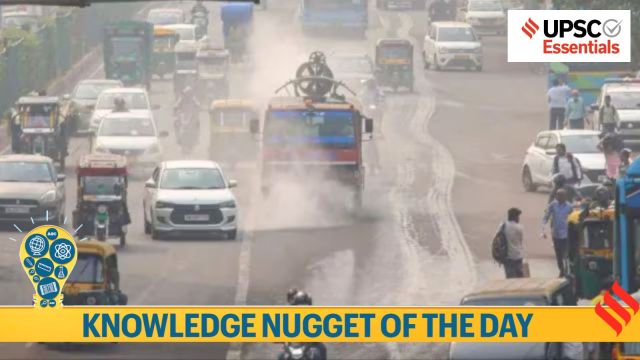A sharp deterioration in air quality from ‘very poor’ to ‘severe’ has prompted the Commission for Air Quality Management (CAQM) to impose the third phase of the Graded Response Action Plan (GRAP) in Delhi-NCR. Although measures under GRAP stage 3 might bring down peak pollution levels, to significantly improve air quality in New Delhi, it is also important to take a host of preventive steps in the national capital as well as the adjoining areas. In this context, let’s know about the GRAP and what the other measures are that can be taken to tackle air pollution.

Key Takeaways :
1. GRAP is a set of emergency measures that kick in to prevent further deterioration of air quality once it reaches a certain threshold.
2. Stage 1 of GRAP is activated when the AQI is in the ‘poor’ category (201 to 300). The second, third and fourth stages are activated three days ahead of the AQI reaching the ‘very poor’ category (301 to 400), ‘severe’ category (401 to 450) and ‘severe +’ category (above 450) respectively.
3. Measures being imposed under the previous categories continue even when the subsequent category is activated, that is, if measures under Stage-2 are activated, measures under Stage-1 will continue to remain in place.

4. Notably, the GRAP was first notified in January 2017 by the Ministry of Environment, Forest and Climate Change. This was based on a plan that was submitted by the CPCB in November 2016.
5. According to the notification, the task of implementing the GRAP fell on the now-dissolved Environment Pollution (Prevention and Control) Authority for the NCR. From 2021 onwards, the GRAP is being implemented by the CAQM.
Story continues below this ad
Major Sources of Indoor Air Pollution
🏗️ Construction Dust
🍳 Cooking Emissions
🕉️ Incense Burning
🧴 Cleaning Chemicals
🗑️ Household Waste
🚪 Poor Ventilation
Headaches
Fatigue
Eye Irritation
Sick Building Syndrome
Asthma
Bronchial Allergies
Reduced Immunity
Respiratory Problems
COPD (Chronic Obstructive Pulmonary Disorder)
Cardiovascular Disease
Cancer
Long-term Organ Damage
Indian Express InfoGenIE
What other measures are needed to improve air quality?
1. Stop municipal solid waste (MSW) burning: MSW is essentially everyday items we use and then throw away. They include product packaging, furniture, clothing, bottles, food scraps, newspapers, appliances, and batteries.
2. Promote the use of electric, BS-VI vehicles: Using Diesel Particulate Filter (DPF) can significantly reduce emissions from diesel vehicles. The introduction of more electric, hybrid and BS-VI vehicles can also help. Improvement of public transport is also necessary.
3. De-SOx-ing and De-NOx-ing systems at power plants: The large power plants and refineries in Delhi emit pollutants like sulphur dioxide (SO2) and nitrogen oxides (NOx). In a bid to limit them, these plants and refineries need to install De-SOx-ing and De-NOx-ing systems that remove SO2 and NOx respectively.
4. Construction materials at construction and demolition sites must be covered: Measures like vertically covering the construction area, covering raw materials, use of water spray and windbreaker to ensure raw materials such as sand don’t fly away, storing waste inside premises, and covering construction materials during on-road movement can improve air quality by 50%, according to the report.
Story continues below this ad
5. LPG to all: Each household must avoid using wood, crop residue, cow dung, and coal for cooking. Everyone should get access to Liquefied Petroleum Gas (LPG), which would bring down levels of PM 2.5, PM 10, and nitrogen oxides (NOx).
6. Petrol pumps should install vapour recovery systems: Petrol contains volatile organic compounds (VOCs) that dissipate into the atmosphere during the unloading of petrol to storage tanks or refuelling of vehicles. These petrol vapours contribute to the formation of smog and pose a potential health risk to the public. Vapour recovery systems help to collect VOCs released during unloading and refuelling and curtail the emissions.
BEYOND THE NUGGET: Air Quality Index (AQI)
1. AQI was launched by the central government in 2014 as part of the Swachh Bharat campaign to help simplify the common understanding of pollution. An expert group comprising medical professionals, air quality experts, academia, advocacy groups, and others was constituted and a technical study was awarded to IIT Kanpur. IIT Kanpur and the Expert Group recommended an AQI scheme.
2. According to the CPCB, the AQI transforms complex air quality data of various pollutants into a single number (index value), nomenclature, and colour. The pollutants measured include PM 10, PM 2.5, Nitrogen Dioxide, Ozone, Carbon, etc.
Story continues below this ad
3. There are six categories of AQI, namely ‘Good’ (0-50), ‘Satisfactory’ (51-100), ‘Moderately polluted’ (101-200), ‘Poor’ (201-300), ‘Very Poor’ (301-400), and ‘Severe’ (401-500).
4. PM 10 and PM 2.5 pollutants are extremely fine particulate matter (PM) particles, with the digits accompanying them referring to their diameter. So, PM 10 and PM 2.5 are smaller than 10 and 2.5 microns in their diameter, respectively. The finer the particles are, the more difficult it gets to protect oneself from them.
5. Due to their size, the PM 2.5 particles can easily bypass the nose and throat and can enter the circulatory system. The particles can also lead to chronic diseases such as asthma, heart attack, bronchitis, and other respiratory problems.
Post Read Question
In the cities of our country, which among the following atmospheric gases are normally considered in calculating the value of the Air Quality Index? (UPSC CSE 2016)
1. Carbon dioxide
2. Carbon monoxide
3. Nitrogen dioxide
4. Sulfur dioxide
5. Methane
Select the correct answer using the code given below:
(a) 1, 2 and 3 only
(b) 2, 3 and 4 only
(c) 1, 4 and 5 only
(d) 1, 2, 3, 4 and 5
Story continues below this ad
(Sources: GRAP III imposed as Delhi AQI turns ‘severe’. Here is what you cannot do, Delhi-NCR’s choking air pollution: 10 ways of making it better)
Subscribe to our UPSC newsletter. Stay updated with the latest UPSC articles by joining our Telegram channel – Indian Express UPSC Hub, and follow us on Instagram and X.
🚨 Click Here to read the UPSC Essentials magazine for October 2025. Share your views and suggestions in the comment box or at manas.srivastava@indianexpress.com🚨



































